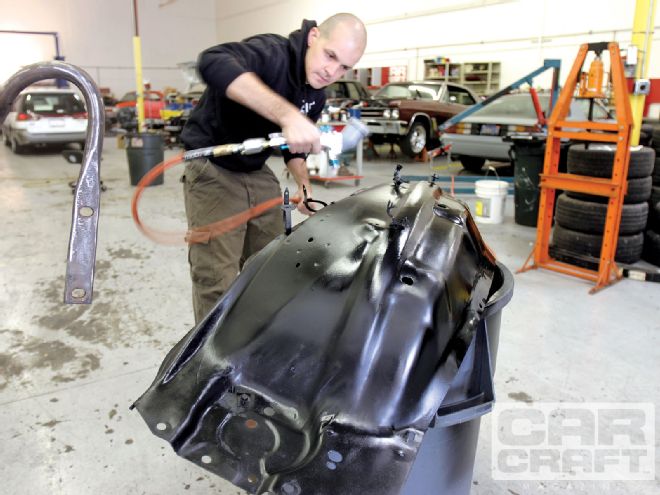
Painting a car is expensive, but it is not out of reach of the average dude on a budget. Recently, we've noticed that several online retailers and a few store-bought brands are coming out with very affordable lines of paint. Though it has been generally true that these low-cost paints don't offer as durable a finish as a high-end paint, some of the new lines are specifically designed for the home hobbyist and, with them, you can get a quality finish that will last for many years with proper care and maintenance. Let's take a closer look.
Painting a Car: Some Terminology
Most modern paint is some type of enamel. New water-based paints are a technology that we will explore later. Within the realm of enamels, there are various subcategories, such as acrylics, alkyds, synthetics, urethanes, and polyurethanes, but don't get too caught up in the nomenclature. For example, urethane is a very general term referring to the type of plastics that make up the resin of the paint-the stuff that sticks to your car. Instead, pay attention to the components: single-component and two-component. You'll also see these referred to as either 1K or 2K, or as one-part and two-part paint.
A single-component enamel is a product that is ready to spray right out of the can. It dries in the air without the need for an activator. Leave the lid off the can and you'll find a dried up hockey puck where your paint used to be.
Mostly, you'll find this stuff in aerosol cans. It's good for things like frames and barbecue grills, but not good for painting a car. Eastwood's Chassis Black is a good example. It is an excellent coating for a car's frame and undercarriage. Single-component enamels generally do not offer good chemical resistance, so solvents like brake cleaner can strip this stuff off quickly, even months after the paint was applied.
What you want for your painting a car is a two-component enamel. These products will not dry when exposed to the atmosphere. An activator must be added to get them to cure. This is good though, because once cured, they are a stronger product with good chemical resistance. You can spill gasoline on them and it won't wrinkle up before your eyes. Painters often refer to the activator as a hardener, so file that bit of jargon away in case someone hits you with it at the paint store.
However, don't think that just because you are adding something to a paint that automatically makes it a two-component product. Usually (but not always) both single- and two-component paints are designed to be thinned with a reducer. They are manufactured "thick" to allow the painter the flexibility to thin the product to suit the atmospheric conditions he will face while spraying. This can cause confusion, however, because you will be mixing two things together (paint and reducer) to spray a single-component product, or likewise, mixing three things together (paint, reducer, and activator) to spray a two-component product. But remember-reducers do not activate the products, they thin them out. You only have a two-component product if you're adding an activator.
To further confuse things, there are two different categories within the realm of a two-component enamel: single-stage and basecoat/clearcoat (BC/CC). However, this concept is easier to wrap your head around. Single-stage paints dry to a glossy finish, but a basecoat does not, it dries to a flat or satin finish and you have to spray clear over it to make it shine.
What to Choose
Using single-stage paints, a paintjob will be more affordable. You only have to buy a single product, not a separate clear. This can be as much as half the cost of a BC/CC paint because clearcoats are just as expensive as base colors.
Single-stage is also faster. You only need to spray enough coats to fully cover the car; usually two will do the job. BC/CC systems often require two coats of color and at least two to three top coats of clear. Add in time to mix all your paint and clean the gun in between the color and clear, and your paintjob will take the better part of a day, and that's if you hustle.
However, you will get a better finish overall if you use a BC/CC paint. The layers of clear add a level of gloss to the finish that is hard to get with a single-stage paint. Plus, your car will keep its color longer because the extra layers of clear act as a UV ray blocker. Likewise, the clear adds an extra layer of protection against minor scratches and rock chips. So if your budget permits it, we recommend a BC/CC system. We've sprayed both with good results, but the BC/CC paintjobs have been far more durable compared with the single-stage efforts.
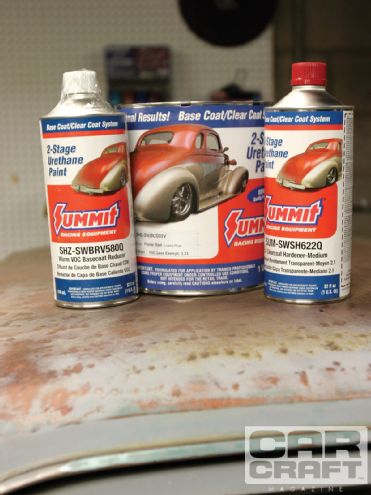 Summit Racing's new line of urethane paints.
Summit Racing's new line of urethane paints.
Mail Order or Walk In
Now that you've got the knowledge, all you need are the materials. It used to be that you had to schlep to some dingy part of town to find an autobody supply store. While some of us are right at home in places like that, others may prefer to do their paint shopping from the comfort and convenience of their home computer. A number of online retailers carry quality and affordable car paints, and two of the most recognizable ones are The Eastwood Co. and Summit Racing.
Eastwood has been selling paint as well as a plethora of other automotive coatings and restoration tools and supplies for years. It offers a quality product at really good prices. We've personally used its single-stage urethanes on a couple of cars, and were really happy with the results. We asked Jack Ruggierio, one of Eastwood's product managers, why the company's prices are lower than those you'll find in a retail store-less than $100 per gallon-and if those lower prices meant subpar performance. JR told us that the prices are low for several reasons: Eastwood is able to buy directly from a major manufacturer in quantities of 500 gallons at a time, it carries only about 50 topcoat colors (rather than hundreds that area retailers need to stock), and it doesn't spend a ton of money marketing its paint. As for the quality, "Because we're buying in bulk, we are able to customize the blend to make the paint easier to spray and give a longer-lasting finish." Eastwood backs that claim up by testing the products it sells. "We set up spray guns and give them to the people in our office who've never painted anything before to see if the formula works or if we need to go back to the manufacturer and make changes. We also spray test panels and old car parts with our paints and leave them out behind our shop to see how they stand up to exposure to the weather," JR says.
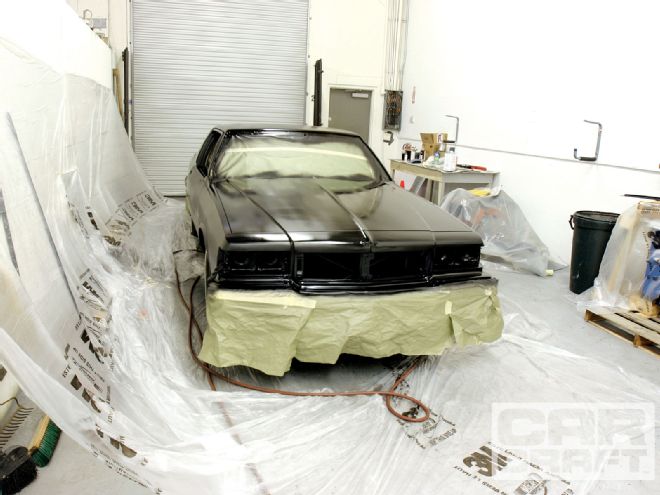 Never mind the skunk stripes, we were in between the first and second coat of Hot Rod Flatz Hot Rod black single-stage urethane on this Chevrolet Caprice. The paint dried to a nice, even, satin finish.
Never mind the skunk stripes, we were in between the first and second coat of Hot Rod Flatz Hot Rod black single-stage urethane on this Chevrolet Caprice. The paint dried to a nice, even, satin finish.
It's possible to spend about $110 and have enough material to spray your entire car with Eastwood's single-stage urethane. The company also recently introduced a line of BC/CC paints. The price of the base is similar to its single-stage, and the clear is very affordable at about $140 for a gallon (including activator).
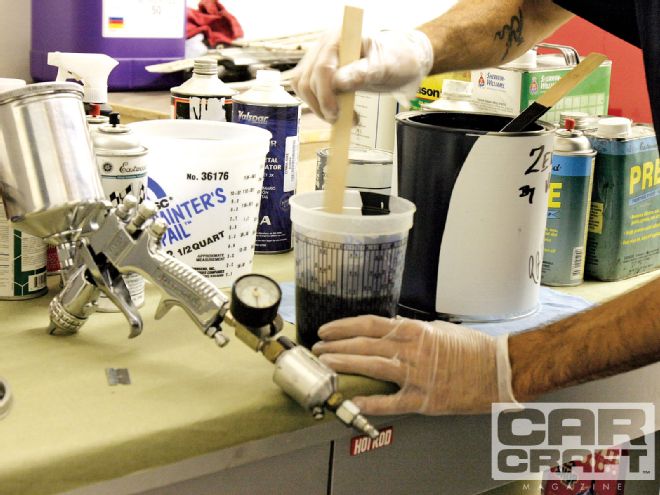 When buying from a store, buy something from a name brand. Be aware that they may not be as user-friendly as Eastwood's or Summit's paints with simple, easy-to-measure mixing ratios. It took us a while to figure out 8:1:0.5 on the mixing cup we had.
When buying from a store, buy something from a name brand. Be aware that they may not be as user-friendly as Eastwood's or Summit's paints with simple, easy-to-measure mixing ratios. It took us a while to figure out 8:1:0.5 on the mixing cup we had.
Summit Racing Equipment recently got into the paint and body business and it also sells single-stage urethanes and BC/CC paint lines at prices competitive with Eastwood's. According to the guys at Summit, customer response has been favorable. "Even guys who paint for a living were very positive about our products." Summit sells a line of 40 mostly solid colors, but you can also buy some metallics and a couple of pearls.
One more option we have personal experience with is TCP Global's line of Kustom Shop paint. We've used its satin paints on a couple of cars, most recently, Tech Editor Smith's '65 Chevelle. This is not expensive stuff either. We paid about $180 for the kit that included a gallon of color and a quart each of reducer and activator. This stuff covered like crazy, too. We sprayed two coats on the land yacht in the photo and had nearly half a gallon left. That was impressive.
The greatest drawback to mail-order paint is you're limited to the colors the retailer sells. If you want something custom, you're going to be visiting a brick and mortar store. Your local autobody supply store will have the means to mix nearly any color you specify, and some of them can color-match an existing color if you are doing a spot repair. Buying from a retailer also means you can go back for more product if you run out. We ran into this situation while painting our Crown Victoria when we realized we needed more paint than we had originally purchased. Luckily the store was only 2 miles away. That would not have worked if we were using mail-order paint.
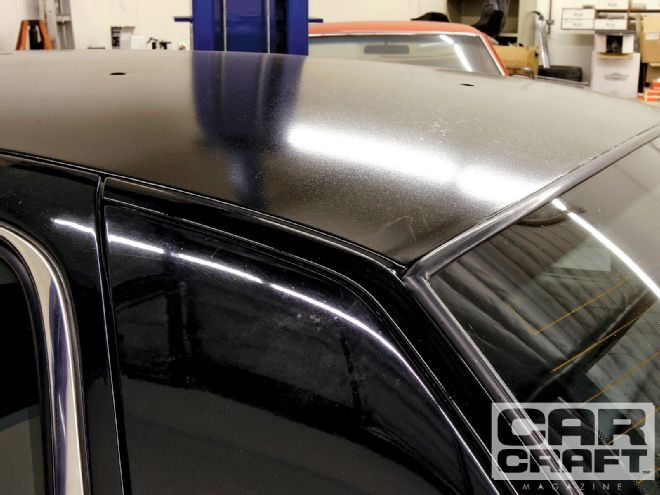 Another caveat is that the reducers and activators all have a limited shelf life and can go bad after a few months of sitting. The paint will look like this roof if you use it. We had to sand all this off and start over.
Another caveat is that the reducers and activators all have a limited shelf life and can go bad after a few months of sitting. The paint will look like this roof if you use it. We had to sand all this off and start over.
The potential downside to buying from retailers is that their economy paint lines are usually fleet colors designed to be applied quickly in a high-volume shop, like a place that churns out taxicabs, for example. These lines of paint may not have the quality and durability that, say, Eastwood is able to specify its their paint line. In fact, Angel Martinez of Top Guns Autobody and Paint Supply in Gardena, California, told us that, in economy paint lines, UV blockers are one of the additives cut to lower the cost. With fewer UV blockers, the quality of the finish will deteriorate over time. It will appear chalky and may even start to chip or flake off after as few as two years of exposure to the elements, even with diligent care and frequent waxing.
A way around this problem is to use a BC/CC system with an inexpensive base and spend more money on a quality clearcoat. "The base just puts the color on the car," Martinez says. "The clear gives you the shine." So you could save some cash using a fleet base color but get a long-lasting finish by using a name-brand clear.
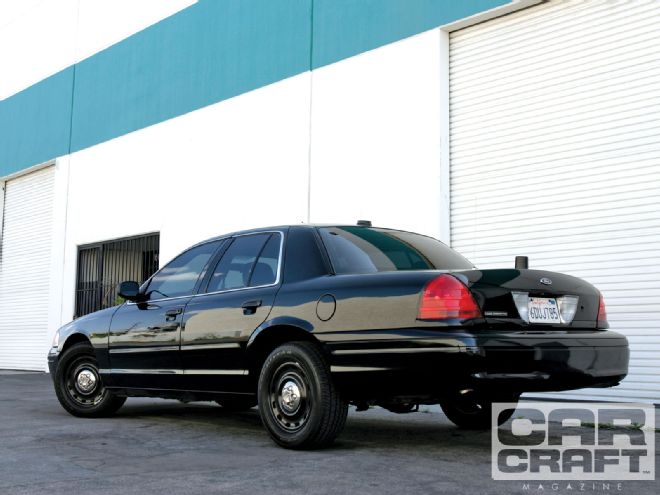 We recommend buying basecoat/clearcoat paint. We sprayed our Crown Victoria with a single-stage urethane, and though the paint is still glossy, it scratches easily (even with microfiber towels!) and requires frequent buffing to stay looking good. If we were to repaint the car, we'd definitely spend extra money on a really good clear that offers a tougher barrier.
We recommend buying basecoat/clearcoat paint. We sprayed our Crown Victoria with a single-stage urethane, and though the paint is still glossy, it scratches easily (even with microfiber towels!) and requires frequent buffing to stay looking good. If we were to repaint the car, we'd definitely spend extra money on a really good clear that offers a tougher barrier.
John Pentecost, a sales rep who's been in the business all his working life reiterated what Martinez at Top Guns told us. "You're giving up longevity because the low-cost paint lines are made with cheaper components. The binders and polymers aren't as good as in the expensive paints." Still, they're not all bad. Pentecost told us all the major paint manufacturers offer lower-cost paint lines, usually sold under a different label, and that they are good products for the money. Dimension is made by Sherwin Williams, Nason by DuPont, and Omni by PPG. Another brand he recommended is Transtar. He's heard good things about its products in his dealings with refinishing shops in his district. So when shopping at your local retailer, we'd recommend buying one of those brands.